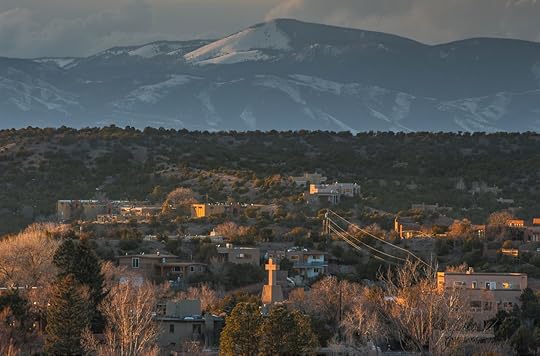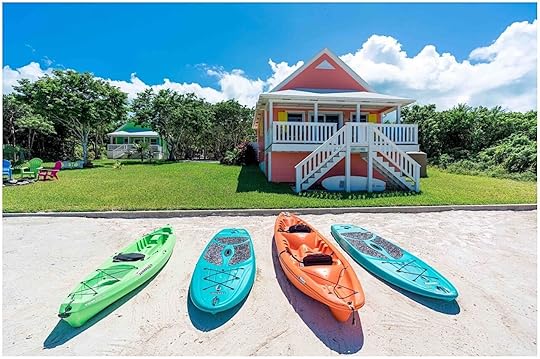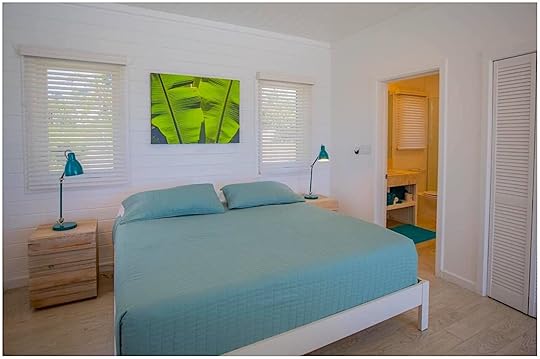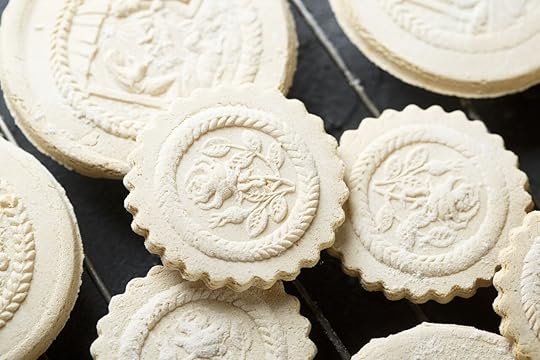Matador Network's Blog, page 557
December 2, 2021
Best US cities for a girls trip

When the going gets rough, the girls get going. Few things do a woman more good than getting away from it all with her besties for a few days (or a few weeks — whatever it takes). But when you’ve done Vegas, Nashville, and Miami, and you’re over your home turf, it can be difficult to figure out where to book tickets for a rejuvenating and fun-filled time away.
In these underrated party cities across the US, you’ll find ideal and affordable destinations for your next girls trip. Whether it’s great eats, a secluded setting, or an over-the-top (and under-the-radar) party scene, these spots will provide you with the getaway you need with your favorite girls by your side.
1. Mackinac Island, Michigan
Photo: Ostrows2/Shutterstock
There’s something about an island setting that encourages you to let loose and enjoy yourself, no holds barred. But this island is no beachy tropical paradise; instead, Mackinac is a 3.8-square-mile seasonal destination in northern Michigan. Tucked between Michigan’s Upper and Lower peninsulas in Lake Huron, Mackinac Island is only open to visitors between the months of May and October, and there are no cars on the island. The only available modes of transportation are bicycles, horse and carriages, or your own two feet. Mackinac is famous for its old-timey charm by day and raucous nightlife scene once the sun sets. One late night of dancing and live music at the Pink Pony and you’ll see what I mean. As the night winds down, whether you take a carriage ride back to the iconic Grand Hotel or book other Mackinac Island lodging options, stumbling home late at night is perfectly safe. Spend your days strolling the quaint Main Street, and make sure to sample all the Mackinac Island fudge you can.
We hope you love the spaces and stays we recommend! Just so you know, Matador may collect a small commission from the links on this page if you decide to book a stay. Listed prices are accurate as of the time of publication. See our full Advertiser Disclosure here.
Airbnb deals in Macinac IslandClean one-bedroom condo with kitchen
Mackinac Island is all about adventure — and your lodging should make that goal as easy as possible. This one-bedroom is fit for three and comes with a full kitchen for meal prep and a gorgeous view out onto the water. You’ll have easy access to everything on (and off) the island.
Three guests, one bedroom
Price: $228 per night
Cross Trees Cottage at East Bluff
If traveling with a larger group, this gorgeous house will keep the festivities going even after you return from town. Sleeping eight across five bedrooms, the house is easy to get to and has an epic wraparound porch for wine sips.
Eight guests, five bedrooms
Price: $985 per night

Photo: Levranii/Shutterstock
Few places are more laid-back than the Florida Keys, and this northernmost key is no exception to the casual “no shoes, no shirt, no problem” vibe. While Key West is the well-known wild child of the Keys, carousing in Key Largo will give you a run for your money, too. Conveniently located just an hour or so south of Miami, the two-lane bridge into Key Largo immediately transports you to island time, where you’ve got nowhere to go and all day to get there. There may be more retirees than millennials living in Key Largo, but trust me, you’ll have a hard time keeping up with the party-hardy locals at hotspots like Gilbert’s, the Caribbean Club, and Sharkey’s. Don’t leave without digging into a fresh fish sandwich at the family-owned Fish House, and any visit to Key Largo must involve a scuba or snorkel trip to John Pennekamp Coral Reef State Park, where you’ll find colorful reefs teeming with sea life — and an underwater statue of Jesus. Stay at Playa Largo Resort & Spa for an ideal base in Key Largo; the beachy resort offers water activities like sailing lessons, sunset cruises, parasailing, and more.
Airbnb deals in Key LargoCanal-front house with pool
This house is pretty much a private resort for you and your crew. Just up from Adams Cut, you’ll have a private boat launch and plenty of room to roam at this large Key Largo house. Dining and shopping are nearby also.
Six guests, two bedrooms
Price: $158 per night
New Home at Key Largo Ocean Resort
Enjoy all the amenities of a beach resort without sacrificing the privacy of a large house. With boat ramp and trailer storage, this home is ideal for girls getaways on the water.
Six guests, three bedrooms
Price: $225 per night

Photo: Jimack/Shutterstock
Anyone into desert vibes and self-care from the inside out will fall head over heels for the spiritually charged city of Santa Fe. Set at an elevation of over 7,000 feet, this hotspot in the American Southwest seems to carry with it an air of mystery, a sense that people play by their own rules here. With ingredients like a funky downtown, New Mexican cuisine, and judgment-free locals, Santa Fe makes for a perfect place to get away from it all. Kick off your trip with a cooking class at the Santa Fe School of Cooking to orient yourself with local eats; then, stay at La Posada de Santa Fe if you desire easy walking access to Santa Fe’s downtown, or check into Sunrise Springs: An Ojo Spa Resort for a completely transportive stay filled with locally inspired spa treatments, mineral soaks, wellness classes, and a meditative 70-acre setting fed by natural springs.
Airbnb deals in Santa FeSunny casita with mountain views
Santa Fe is all about the casitas. Few are as iconic as this one — right along the Northern Hills and featuring an outdoor patio with tons of room to relax. The decor is classically southwestern, which of course puts you in the mood for desert revelry (which happens to be right outside the door).
Six guests, two bedroom
Price: $122 per night
Capital Casita located downtown
If a luxury retreat is in order, look no further than this casita right in the heart of the city. Bright, well-trimmed, and with a gorgeous backyard, your crew will revel in the charm of the southwest’s most impressive city — and be able to walk to its best attractions.
Four guests, two bedrooms
Price: $195 per night

Photo: CrackerClips Stock Media/Shutterstock
Branch out from South Beach and check out the rest of South Florida. Cities like Fort Lauderdale and West Palm Beach are on the rise, offering the heat and flavor of the Miami experience for a fraction of the price — and with a lot less traffic. For drinks with a view, check out the new bar Rooftop, or check into any of the modern-luxe resorts lining Fort Lauderdale Beach if you’d prefer to enjoy amenities like spas, rooftop pools, chef-driven restaurant concepts, and more. Fort Lauderdale’s white-sand beach is significantly less crowded than anywhere you’d find in Miami but just as eye-catching. Head to Las Olas Boulevard for shopping and restaurants, FAT Village for an art-filled industrial district (and murals that make for perfect Instagram backdrops), or Riverwalk for a pleasant waterfront stroll. Best of all, the recent advent of the high-speed Brightline train gives you the ability to hop between Fort Lauderdale, West Palm Beach, and Miami in under an hour, so the party never has to stop.
Airbnb deals in Fort LauderdaleLuxury beachfront house with pool and bar
Oceana Blue is the type of place beach dreams are made of — a pad where you can literally soak in the pool while sipping a fruity cocktail and looking out at the actual ocean. The house itself is fit for a crew of twelve and major bonus, there are six bathrooms. No more waiting in line.
Twelve guests, six bedrooms
Price: $1,200 per night
Nautical beach house steps from the beach
Capture the true essence of the Keys at this nautical-themed beach house. The home includes a pool, garage, and tons of lounge room along with a chef’s kitchen.
Six guests, three bedrooms
Price: $605 per night

Photo: Peter Bowman/Shutterstock
Santa Maria Valley, set along California’s dramatic Central Coast, is a visually stunning, affordable, and largely unknown destination for a girls trip. It’s located halfway between Los Angeles and San Francisco, making it accessible yet irresistibly off on its own. With 13 beaches, 34 wine tasting rooms, and 24 hikes all within a 30-minute drive, there’s no way your group will grow bored. Whether you and your friends are in it for the wine scene — the area is known for its chardonnays, pinot noirs, and syrahs — or adventurous activities like hiking, cycling, and riding dune buggies, Santa Maria Valley is the kind of spot that’s sure to receive an immediate thumbs-up text from everyone in your group chat.
Airbnb deals in Santa Maria ValleyOceanfront condo in Pismo Beach
You’re here for the beach and outdoor getaways. You might as well stay on the beach — and there’s no better place to do so than this oceanfront condo. Watch the sunset over the coast and stroll the sand right from your door.
Four guests, two bedrooms
Price: $399 per night
Spanish villa steps from the ocean
Central California is known for its Spanish-influenced architecture. This home is living proof as to why — a palm-lined, fenced home finished in vibrant Spanish trim and surrounded by agave. This spot is luxurious as well; your crew will enjoy a ping pong table and home theater, BBQ area, and lots of outdoor lounge space.
Twelve guests, eight bedrooms
Price: $839 per night

Photo: Jon Bilous/Shutterstock
Considered the Las Vegas of the East Coast, Atlantic City is dotted with casinos, resorts, hotels, and restaurants along its landmark four-mile boardwalk and six miles of beach. The city is within driving distance of one-third of the country’s population — both New York and Philadelphia are easily accessible from Atlantic City — so chances are, all your girls can find a way to make the trip. Whether you head to Atlantic City for the nonstop party, the daily headlining entertainment, the spas, the shopping, or simply the friendlier price point, this oceanfront spot somehow remains under the radar, giving you the chance to enjoy a memorable time without the stressful bustle of more popular girls-trip destinations. To kick off your night, check out the rock-n-roll tequila bar called Gypsy Bar inside the Borgata Hotel Casino & Spa, then choose from a range of fine-dining restaurants by celebrity chefs, including Bobby Flay, Wolfgang Puck, Geoffrey Zakarian, and Michael Symon.
Airbnb deals in Atlantic CityTwo-bedroom condo in gorgeous highrise
Live the AC life to the max in this modern condo. You’ll be within walking distance or a short Uber to dining, party spots, and beaches. Plus, when you do return to the condo, your spot is trimmed with all the fixings of a luxury casino resort.
Six guests, two bedrooms
Price: $325 per night
Eight-bedroom mansion with waterfront decks
Here’s the thing about Atlantic City. Beachside condos are everywhere. What’s NOT everywhere are historic mansions that give your crew the privacy to be yourselves and the access to hit the town when the time is right. That’s where this legendary mansion comes in. Beach access? Yes. Plenty of room to lounge at home? Of course. Dining, shopping, and nightlife? You’re surrounded by it.
Sixteen guests, eight bedrooms
Price: $413 per night

Photo: rukawajung/Shutterstock
If you’ve seen and done it all in Nashville, consider heading an hour north to Bowling Green, Kentucky. This down-home spot is relaxed yet packed with unique activity options, from trekking the longest underground cave system in the world at Mammoth Cave National Park to taking a zip-line tour at Lost River Cave. If you end up staying out way past your bedtime, no worries: you’re up at the perfect time for a sunrise hot-air balloon ride over Kentucky’s rolling green hills. Penthouse suites at the Kentucky Grand Hotel & Spa start at just $459 per night, so you and your girlfriends can live it up without breaking the bank. Combine your trip with a jaunt to Louisville to enjoy the Urban Bourbon Trail; the state of Kentucky is the birthplace of bourbon, after all.
Airbnb deals in Bowling GreenCountryview villas for 12
Relax with plenty of space in this large home. You’ll have 3.5 private acres of land surrounded by forest, with hiking and in-town activities not far away. Downtown Bowling Green is only eight minutes.
Twelve guests, five bedrooms
Price: $269 per night
Downtown industrial modern house
Stay right in the heart of Bowling Green in this high-end but approachable industrial modern home. The interior is trimmed like your in the trendiest part of a hip big city, but outdoors you’re clearly in rural Kentucky. Walk around town, or chill at the homestead — or better yet. alternate between the two.
Twelve guests, five bedrooms
Price: $446 per night

Photo: The World in HDR/Shutterstock
If you and your girls are into classy escapes to world-renowned ski capitals, look no further than ritzy Aspen, Colorado. There’s a reason it’s a preferred winter destination for celebrities and the jet set. Spend the day on the slopes, then defrost your digits with après ski libations and comfort foods — after all, you won’t have to worry about squeezing into a bikini on this snowy trip. Heat things up in one of the town’s nightclubs, like Escobar or Bootsy Bellows (an outpost of the Sunset Strip hotspot), or find a hot tub somewhere to decompress in quintessential ski-bunny fashion. If you’re in town after President’s Day, scout out the Oasis Veuve Clicquot, a secret pop-up bar that moves locations every weekend. Don’t worry if a ski-season trip isn’t in the books this year: in the summertime, Aspen transforms into an outdoor lover’s paradise, highlighted by mild weather and sunny hikes among fields of wildflowers.
Airbnb deals in AspenSki-in, ski-out condo on Shadow Mountain
Make it easy on everyone by booking a ski-in, ski-out condo that’s also walkable to Aspen’s best restaurants and nightlife (including the legendary Belly Up). No matter whether or not you ski, this condo embodies the Aspen lifestyle — upscale, chic, and with no car required to enjoy the town.
Six guests, three bedrooms
Price: $641 per night
A $5 million residence for a three-figure sum
Aspen is famously expensive. But this luxury villa lets you live the lifestyle for an affordable nightly rate. Right downtown, there are famous chefs cooking right up the road and more cozy mountain pubs nearby than you could possibly hit in one visit. The home itself is nice, too — we suggest sunset cocktails on the deck.
Eight guests, three bedrooms
Price: $450 per night

Photo: Sean Pavone/Shutterstock
Home to live music venues and breweries, Memphis is made for girls trips where late nights, great drinks, and high energy are a must. From historic Beale Street to the Levitt Shell, where Elvis Presley held his first public performance, this music capital invites visitors to sing along to the most popular tunes of yesterday and today. To balance out the beers and bar crawls, Memphis also holds space to unwind in nature. At over 4,500 acres, Shelby Farms Park is one of the largest urban parks in the country, and visitors can rent a canoe or kayak on the lake or go on a horseback tour of the park. Alternatively, get the girls together for a downtown bike ride across the longest bridge on the Mississippi River, Big River Crossing, which stretches from Tennessee to Arkansas. And no, it’s not your imagination: drinks really do taste better in Memphis. The city sits on an aquifer, and all spirits are made from a base of this naturally filtered water.
Airbnb deals in MemphisLuxurious getaway with heated pool
Memphis Airbnbs often come in behind Nashville Airbnbs for girls trips. This upscale home proves it shouldn’t. You’ll have a heated pool in a comfy home surrounded by a jungle oasis — all in the heart of the city. Did we mention the pool has a waterfall?
Sixteen guests, six bedrooms
Price: $219 per night
Midtown home on legendary Madison Avenue
This home is smack in the middle of the best Memphis has to offer. Stroll to dining and nightlife, Uber to outdoor and cultural attractions. We also suggest dedicating at least one afternoon to simply walking through Midtown and seeing what you come across — likely, you’ll find not only unique characters but fun times popping in and out of shops and pubs, too.
Ten guests, four bedrooms
Price: $275 per night
 More like thisFemale Travel7 epic winter vacations to take with your girlfriends
More like thisFemale Travel7 epic winter vacations to take with your girlfriends
This winter hit the slopes with 30 percent off your snowboard and ski rental

It’s December, meaning it’s about time for some dashing through the snow. Ditch the sleigh and hit the slopes at any one of 50 ski destinations in North America and Europe, like Cortina d’Ampezzo, Italy, Lake Tahoe, or Jackson Hole, Wyoming, and take advantage of a snowboard and ski rental discount delivered straight to your lodging. TravelZoo is offering a deal with Ski Butlers, the full-service ski and snowboard rental delivery company, that will take care of all your equipment needs and even pick up your rentals when you’re done.
We hope you love this Travelzoo ski rental discount Travelzoo! Just so you know, Matador may collect a small commission from the links on this page if you decide to book a stay. Listed prices are accurate as of the time of publication. See our full Advertiser Disclosure here.
Travelzoo members can get up to 30 percent off ski and snowboard equipment. Book for two people and get 20 percent off, three to four people and get 25 percent off, or five or more people and enjoy 30 percent off. Mix and match ski and snowboarding equipment so everyone can pick their favorite activity. No matter what age, ability level, or terrain choices, Ski Butlers has packages that include everything you’ll need and will handle delivery, any equipment support, and pickup services. For an extra cost, add on helmets, goggles, high-performance boots and damage waivers.
TravelZoo is offering this deal valid now through March 31, 2022, with the exception of December 24-31, January 1-2, and February 17-21, 2022. This ski rental discount package is also 100% refundable if you decide to pass more than 24 hours in advance.
Be sure to book now! With a deal this good, there’s no reason not to hit the slopes. 
These US national parks are home to epic backcountry skiing

Backcountry skiing and national parks are a perfect combination of two of America’s favorite pastimes. For an avid outdoors-person, spending a winter day backcountry skiing in a national park is about as good as it gets — but you have to know where to go.
Many high-altitude through-roads in parks often close in winter, leaving skiers and snowboarders to strap on their skins and earn those turns. The good news is that no matter where you live in the western United States, backcountry turns inside national park boundaries are doable. And these five national parks offer particularly intriguing lines.
Before heading out, dive into Matador’s guide to planning a backcountry ski or snowboard trip for safe trip planning and stock up on the latest ski trip gear.
Rocky Mountain National ParkGrand Teton National ParkCrater Lake National ParkGlacier National ParkLassen Volcanic National Park1. Rocky Mountain National Park, Colorado
Photo: Nicholas Courtney/Shutterstock
Season: December through MayNearest town: Estes Park, COAbout 90 minutes from Denver, Rocky Mountain National Park offers some of the most accessible touring terrain near the city. Being the alpine sanctuary that it is, RMNP (in local parlance) is loaded with ski lines.
Hidden Valley is the most popular trailhead for backcountry touring in Rocky Mountain National Park. There, you’ll find beginner and intermediate terrain accessible in with as little as 30 minutes of climbing. And there’s a reason the national park’s backcountry skiing is so amazing: it used to be an actual ski resort, lift included. You can still see the wide-open run where the non-backcountry skiers of yore made their turns. You’ll use the same run, or at least the bottom part of it, to return to the parking lot. For a longer and more challenging route, follow the skin track up until after it crosses the highway switchback and ducks into the trees.
Experienced skiers and splitboarders will want to head to the Banana Bowls. If you’re able to commit to a 2-hour hike, your reward is a long 30-degree cruiser that offers unbeatable views across the Continental Divide from from Flat Top Mountain. And skiing in the bowls doubles as a geography lesson. The snow here feeds into the Colorado River (formerly known as the Grand River), which flows from RMNP through Grand County and across western Colorado before cutting through Utah towards the Grand Canyon. You’re literally skiing the snow that feeds the most important river in the American West.
2. Grand Teton National Park, Wyoming
Photo: Kevin Cass/Shutterstock
Season: December through AprilNearest town: Jackson Hole, WYThe Taggart Lake trailhead puts you in the Grand Tetons within an hour. It takes just a quick glance at photos of the Tetons for it to be apparent that mellow cruisers aren’t really an option, so tune your edges and be prepared for steep ascents and descents.
From the skin track, turns on 25 Short and Maverick’s are accessible for intermediate and advanced skiers or riders. For a real mountaineering experience, grab the crampons and ice axe and hit the trail early to reach Apocalypse Couloir, Silver Couloir, or the famed Northwest Passage. Guided tours are available and encouraged with reputable operators like Samsara Experience, led by iconic big-mountain athlete Zahan Billimoria. Heads up: expect a $30 fee to enter and park in the lot unless you’re with a tour or in a commercial vehicle.
3. Crater Lake National Park, Oregon
Photo: Giulia Sassu /Shutterstock
Season: December through MayNearest town: Prospect, ORFor picture-perfect snow-meets-water views, Crate Lake National Park backcountry skiing can’t be beat. The views are on par with skiing Homewood Mountain Resort at Lake Tahoe, which has trails that look like you’re going to ski directly into the massive lake.
The West Bowl and West Chute off the park’s Garfield Peak are the most iconic lines in Crater and both accessible via a tour of around four miles. Plan two hours of travel time to reach the transition point. The runs are steep — 30-degrees or more in many spots — but offer open turns for those not comfortable winding through tight trees. And, bonus: the 1,200-foot descent leads right back to the trailhead, meaning no need to transition back to tour mode or deal with a grueling hike out after your run. Not ready to commit to long lines? Applegate is another great run. It’s more mellow and open but offering equally striking vistas as you send it downhill.
4. Glacier National Park, Montana
Photo: Jiri Kulisek /Shutterstock
Season: November through MayNearest town: West Glacier, MTNothing about skiing in Montana is small. The lines are big. The ascents are big. And the views are even bigger. And Glacier National Park’s backcountry skiing is proof. Sure, you can take it relatively easy and stick to the low-angle trees of Marias Pass or the open run above Lake McDonald. At both those sites, the uphill takes an hour at the most and knocking back two or three laps in a half-day is totally doable if you hustle. But the big turns happen deeper within the park.
The Apgar and Two Medicine trails lead to bigger runs with longer tours, going as far back and as high up as conditions and time allow. Be sure to pack plenty of food and water, and don’t forget emergency gear. The park’s furthest-in trails are extremely remote and reaching your crew (or a rescue crew) in an emergency can take some time.
5. Lassen Volcanic National Park, California
Photo: Dominic Laniewicz/Shutterstock
Season: March (or earlier) through JuneNearest town: Mineral, CALassen Volcanic National Park is the wild card on this list of the best national parks for backcountry skiing. You might not think backcountry skiing on a volcano sounds like a good idea, but the North Ridge of Lassen Peak gets as steep as 45 degrees (though much of the riding is far more mellow). The peak offers more than 3,000 feet of vertical and big, wide turns. Plumes of sulfuric steam greet you as you arrive down towards the base of the mountain, and your crew will likely have the benefit of being the only people there to revel in the unique experience; it’s one of the least-crowded parks in the park system.
When headed to Lassen, set aside a full day. Hiking 3,000 feet of incline takes a while (though if you go in May, the road will likely be open to take you much of the way). In winter, the skin up is much farther and you can’t shuttle to lessen the burden.
Like the backcountry ski legend Jeremy Jones says, “The attraction of snowboarding is the freedom it gives you.” Even if you’ve skied the countru’s biggest and best resorts, few experiences are as freeing and satisfying as earning your turns via the “Heel-toe Express.” 
Myrtle Beach: Find your happy place

Every year, Myrtle Beach draws some 20 million visitors with promises of endless soft sand, world-class golf, mouthwatering seafood, and just about everything under the sun — every pun intended — in the realm of entertainment and adventure.
And most of them come back, and then back again. A haven for every generation, it’s simple to find your happy place here, in any season. As far as we can tell, it only takes four steps.
Step one: Find your beach.
Photo: Visit Myrtle Beach
The Grand Strand — Myrtle Beach’s coast, essentially — runs for 60 miles of beautiful sand and surf. Stretching from Little River to Pawleys Island, each beach-y spot is different, so find whichever calls most strongly to you. Let’s break down the highlights:
Surfside Beach is known throughout the region as the “family beach.” Smaller crowds, dozens of beach access points, seven public parks, and wide-open sand are just a few of the perks. (It also became the first official autism-friendly travel destination in the world in 2016.)The proximity of Garden City Beach to the inlet makes it a popular destination for fishing — among beginners and veterans alike — and watersports. As a bonus, The Pier at Garden City is free for those looking for a pleasant seaside stroll.North Myrtle Beach, a nine-mile stretch of sand, is the perfect blend of coastal retreat and entertainment. Go for a relaxed walk on the shore during the day; by night, get swept up in the sounds of beach music along Ocean Drive or by the award-winning restaurants and entertainment venues.Myrtle Beach is the “Heart of the Grand Strand.” Think nonstop energy from sunrise to sunset and beyond. The nearly 200-foot-high SkyWheel, located just feet from the sand, provides a bird’s-eye view of the beach in both directions, should you want to get your bearings (or simply enjoy the ocean breeze from elevation).A smaller community, Litchfield Beach is a good spot to post up if you’re traveling with nine-irons. You can expect more sea oats than sunbathers on the sand, yet it’s still in close proximity to all of the entertainment that is Myrtle Beach.Pawleys Island, 25 miles south of Myrtle Beach, is a tiny hamlet on a barrier island with several homes dating back to the late 18th century. The pace of life here is as slow and serene as it sounds.Step Two: Find your community.
Photo: Visit Myrtle Beach
There are 14 unique communities set along these 60 miles of coastline. Families who have been coming to Myrtle Beach over the years usually return to the same place, passing along the tradition to the next generation. New visitors just need to find their niche. Beyond the highlights noted above, here are a few more spots that could be your perfect vacation home away from home:
Located along the Waccamaw River, the historic homes and buildings of Conway create a charming backdrop to the scenic Conway Riverwalk. The annual Conway Riverfest highlights the area’s amenities with a weekend of music, food, and activities. The town is also home to Coastal Carolina University. Go Chants!Just south of the North Carolina border, Little River was a popular haunt for pirates in the 18th century. Each May, the town hosts the World Famous Blue Crab Festival, while in October the Little River ShrimpFest pays homage to another delicacy from the sea.We would be remiss if we didn’t mention the Loris Bog-Off Festival, in Loris. “Chicken bog” is a local delicacy that features chicken, sausage, rice, and a myriad of spices — grab a plate at this October event.Atlantic Beach was first established in the 1930s for Black families. Many of the area’s current residents are descendants of enslaved peoples from West Africa, known as the Gullah Geechee. Today, locals are actively working to preserve the rich history and culture of the town.Carolina Forest, a relatively new development, stays true to its name — nearly half of this residentially developed area preserves its natural setting. And yet, shopping opportunities abound.The “Seafood Capital of South Carolina,” Murrells Inlet was once the stomping grounds of Edward Teach, the infamous pirate known as Blackbeard. Try to imagine the Queen Anne’s Revenge anchored within sight of The Marshwalk, a 1,400-foot boardwalk winding along the marsh here.Step three: Go beyond the beach.
Photo: Craig Zerbe/Shutterstock
While most people visit Myrtle Beach for one-on-one time with the sea and sand, if that’s all you do then you’ll be missing out on one of the nation’s largest country music festivals, two state parks, an incredible botanical garden, awesome entertainment venues like the Alabama Theatre and The Carolina Opry, and celebrity-designed golf courses from the likes of Arnold Palmer, Greg Norman, and Robert Trent Jones. Bottom line: There’s so much here beyond the beach.
And that includes history. Huntington Beach State Park — think wide-open sand, quiet salt marshes, “seabreeze camping” — was once the coastal portion of a rice plantation. Early in the 20th century, Archer and Anna Huntington purchased the plantation and built their winter home on these oceanside grounds. Known as Atalaya Castle, the Moorish-style mansion is now open to visitors, right in the state park.
Just across what’s now Highway 17, the Huntingtons also created Brookgreen Gardens, in part to display Anna’s sculptures and other artistic works. Today, this botanical wonderland — one of the best public gardens in the county, bar none — still features a sculpture garden, alongside a wildlife preserve and Lowcountry zoo.
Watersports are also a very “Myrtle Beach” way to experience this coastal gem, and they can look like whatever you want. Kayak the maze of backwaters, blackwater rivers, and coastline; go jet-skiing along the shore; rent a pontoon boat and stock up that cooler; or charter a deep-sea fishing excursion or dolphin-watching tour. This is also one of the best angling spots on the East Coast, and you don’t need a license if you’re just fishing off-pier (or if you’re on a deep-sea charter, reeling in king mackerel).
Step four: Dive into the food scene.
Photo: Visit Myrtle Beach
In Myrtle Beach, good restaurants are nearly as plentiful as seashells on the beach — pick one up, toss it, and you’ll land near a winner. The East Coast’s finest seafood fills most local menus, but if you need some suggestions, here are a few of favorites:
Hot Fish Club . The original Hot Fish Club was founded in 1792. That’s not a typo! Sure, the original was located several miles away from the current iteration in Murrells Inlet, but its legacy lives on untouched. Lee’s Inlet Kitchen . Founded 73 years ago in Murrells Inlet, this is the only restaurant in the area that’s been owned and operated by the same family since its founding. It’s also consistently voted one of the best. Sea Captain’s House . What was originally built as a 1930s sea cottage has evolved into a must-have Myrtle Beach dining experience. With the menu sporting items like bacon-wrapped scallops and she-crab soup, this is one house you won’t mind visiting year after year. Hook & Barrel . Serving sustainably sourced seafood dishes and local produce, Hook & Barrel provides a one-of-a-kind dining experience in an eco-friendly setting. “One nibble and you’ll be hooked,” they say.For the record, these steps can be accomplished in any order, so chow down, surf’s up, or settle in. Your happy place is just four steps away. 
Jaw-dropping ‘House of Gucci’ villa is available on Airbnb

If you love drama, luxury, scandal, and a star-studded cast, get yourself to the cinema to see House of Gucci. But if you’d rather experience all of that in person, the jaw-dropping Lake Como villa from the feature film is now available for a one-night stay on March 30, 2022, on Airbnb.
We hope you love the House of Gucci Airbnb we recommend! Just so you know, Matador may collect a small commission from the links on this page if you decide to book a stay. Listed prices are accurate as of the time of publication. See our full Advertiser Disclosure here.

Photo: Airbnb
The villa boasts waterfront views, six bedrooms, six bathrooms with stunning bathtubs, a private elevator, a beautifully manicured garden, an outdoor swimming pool, a private pier, and a boathouse.

Photo: Airbnb
The interior of the villa bestows old-world charm. Centuries-old art and furniture grace the residence including 17th-century frescoes painted by the Recchi brothers and Agostino Silva. Each suite was designed by the renowned interior decorator Jacques Garcia.

Photo: Airbnb
If you still need convincing of its grandeur, see Villa Balbiano in House of Gucci, in movie theaters from November 24. The villa will be available for booking on Airbnb on December 6 at 12:00 PM EST. 
7 of the most breathtaking Airbnbs in the Bahamas

Picture this: You’re lounging in the shade of a thatched umbrella, running your toes through soft pink sands as blue-green waters lap at the shore, snacking on cracked conch and spiny lobster, chasing each bite with a swig of rum punch. Maybe you’re resting after swimming with pigs or riding the slides at an epic new waterpark. Maybe you’re fueling up for a night of dancing to rake-and-scrape tunes. This is what a vacation in the Bahamas looks like. To make your Bahamian daydreams a reality, we’ve scouted seven of the most irresistible Airbnb Bahamas rentals across the archipelago, from the capital of Nassau to quiet Eleuthera Island. Take a look, and we dare you not to book.
We hope you love the Airbnb Bahamas rentals we recommend! Just so you know, Matador may collect a small commission from the links on this page if you decide to book a stay. Listed prices are accurate as of the time of publication. See our full Advertiser Disclosure here.
1. Golden Chalice cottage on Bird Point Beach
Photo: Airbnb

Photo: Airbnb

Photo: Airbnb
If the canary-yellow paint job fails to make you smile, those ocean views and teardrop pool sure will. The one-bedroom cottage is perfectly positioned on Eleuthera, right next to Tippy’s Restaurant and Beach Bar, whose chalkboard menus and live music have been known to attract the odd patron that’s as famous as the local haunt. A rental car is recommended for this part of town, especially if you’re looking to track down the island’s iconic pink-sand beaches.
Sleeps: Two guests, one bedroom
Price: $579 per night

Photo: Airbnb

Photo: Airbnb

Photo: Airbnb
Bahamian beachscapes, meet Airbnb Luxe. Features like a personal concierge, gourmet kitchen, and premium Bose sound system earned this three-bedroom townhouse its five-star status, which comes with optional add-ons like chef, maid, and nanny services. There are also perks to being part of the Palm Cay Resort, including access to the on-site marina, clubhouse, spa, and tennis courts. Outside the resort gates, golfers can hide away at the Ocean Club Golf Course while the rest of the group enjoys the nearby shops, eateries, and nightlife venues.
Sleeps: Six guests, three bedrooms
Price: $795 per night

Photo: Airbnb

Photo: Airbnb

Photo: Airbnb
Honeymooners, take note. This gorgeous one-bedroom villa on Eleuthera was made for a romantic retreat. There’s a private plunge pool, patio seating for candlelit dinners, and amenities for both restful days on Rainbow Bay Beach or snorkeling adventures out in the sea. You’d be hard-pressed to find even a whiff of a negative review of Villa Soreli, and with an interior as immaculate as the views, we can totally see why.
Sleeps: Four guests, one bedroom
Price: $275 per night

Photo: Airbnb

Photo: Airbnb

Photo: Airbnb
Groups who plan beach vacations around the max number of outdoor activities they can jam into a trip will adore this two-bedroom home in small-town Spanish Wells. Kayaks and paddleboards are included in the rental, as is a golf cart to get around the island. When your crew finally needs a rest, take advantage of the complimentary beachfront day beds, then refuel at the Sandbar grill a stone’s throw from the house.
Sleeps: Four guests, two bedrooms
Price: $350 per night

Photo: Airbnb

Photo: Airbnb

Photo: Airbnb
There are a lot of reasons to pick this guest suite in Nassau, but location tops the list. It’s a quick walk to a private beach, a short drive to shops and restaurants, and a tiny hop to the pool of the utterly serene, gorgeously green host property. A cleaning service complete with light laundry is included, and guests can elect to have breakfast on-site for an extra $30 per day.
Sleeps: Three guests, one bedroom
Price: $210 per night

Photo: Airbnb

Photo: Airbnb

Photo: Airbnb
What better way is there to cap a day of snorkeling than cracking open a cold one, firing up a barbecue, and grilling up a seafood feast, Bahamian-style. At this three-bedroom bungalow in Gregory Town, a laidback settlement on Eleuthera, both the snorkel gear and barbecue are provided. With room for six — split between a king bed, queen bed, and two single beds — this is a perfect Airbnb Bahamas rental for families with kids of all ages. Minus the post-snorkeling beers, of course.
Sleeps: Six guests, three bedrooms
Price: $350 per night

Photo: Airbnb

Photo: Airbnb

Photo: Airbnb
This palatial villa isn’t even close to the most expensive Airbnb Bahamas rental — see: this private island with a nightly rate that’s roughly equivalent to the downpayment on a quarter-mill house — but it is the priciest property on this list. Split it eight ways, though, and the four-bedroom dream house in Nassau starts to look surprisingly attainable. Bachelors, bachelorettes, friends, family–whatever group you work on cobbling together, be sure to pitch the infinity pool and optional chef service for an easy sell. 
Sleeps: Eight guests, four bedrooms
Price: $1,020 per night
December 1, 2021
Most beautiful Christmas trees

If you need a little help to get into the holiday spirit this year, get yourself a winter drink with a side of holiday treats and a tour of the world’s most beautiful Christmas trees. These towering pines (or sand piles, in some cases) are decked to the nines and shine brightly for celebrants around the world to enjoy. Here are the nine most beautiful Christmas treesfrom around the world, from Florida all the way to Lithuania.
1. Zócalo Christmas tree — Mexico City, Mexico
Photo: Henryk Sadura/Shutterstock
Christmas time in Mexico City welcomes the return of a gigantic tree in Zócalo Square. With the Metropolitan Cathedral behind it, the holiday display makes Centro Histórico even more scenic than it already is. In past years, the Christmas experience in Zócalo Square was completed with a nearby ice skating rink and even a light and music show. Note that the tree is not on display every year so if you’re thinking of traveling to it, be sure to check in advance.
2. Rockefeller Center Christmas tree — New York City, New York
Photo: Rockefeller Center
When it comes to Christmas decorations, you just can’t beat New York City. Perhaps the most famous Christmas tree in the world, this year the Norway spruce at Rockefeller Center is 79 feet tall and is 46 feet wide. The brilliantly lit tree is a long-standing American tradition dating all the way back to 1931 when construction workers were building Rockefeller Center. The tree typically has five miles of string lights and a 900-pound star topper made of 3 million Swarovski crystals. The lighting ceremony took place on December 1 this year, and the Christmas tree will stay lit and displayed until early January from 6:00 AM to 12:00 AM every day (except for Christmas Day when the beautiful Christmas tree is lit for 24 hours and on New Year’s Eve it is lit from 6 AM to 9 PM.)
3. Sandi — West Palm Beach, Florida
Photo: The City of West Palm Beach/Facebook
Florida doesn’t get any snow during the holidays (or ever), so it makes do with what it has in abundance: sand. Beginning in early November, sand is delivered by the truckload to the West Palm Beach waterfront, where sculptors begin shaping the massive pile into a 35-foot Christmas tree. West Palm Beach’s Sandi tree is the world’s only 700-ton sand tree and is illuminated with choreographed light and music shows nightly from 6:00 PM to 10:00 PM throughout the holiday season, starting on December 2, 2021 at 6 PM. This year, Sandi (the name of this unusual Christmas tree) turns 10 years old and has been nominated a for the 10 Best Public Holiday Lights Displays ranking by USA Today.
4. Floating Christmas tree — Rio de Janeiro, Brazil
Photo: Donatas Dabravolskas/Shutterstock
Revelers like to do it big in Brazil, and Christmas time is no exception. Rodrigo de Freitas lagoon in Rio de Janeiro is home to what has to be one of the most unique Christmas trees in the world: a floating tree that stretches over 270 feet into the sky, a tradition that began alongside a dazzling fireworks display in 2014. The tree has to be constructed on a barge each year and is lit up with more than three million lights, attracting around 200,000 visitors. There’s no word as to whether or not Lagoa Christmas Tree will be lit this year or if there’ll be a fireworks display. The event does not take place every year.
5. Galeries Lafayette Christmas tree — Paris, France
Photo: Galeries Lafayette/Facebook and Galeries Lafayette/Instagram
A stunning four-story Christmas tree is placed inside the Galeries Lafayette department store each year in Paris, France, and it always has a different theme to surprise and delight shoppers. Past themes have included “From another planet,” featuring meteoric decorations, and “An Amazing Arctic Christmas,” which was made entirely of paper by French artist Lorenzo Papace. This year, the beautiful Christmas tree, inaugurated on November 17, is decorated with the toys featuring a fantastic fairy tale, complete with an astronaut Santa and a futuristic toy rabbit. Every 30 minutes, the stores goes dark and visitors can enjoy sound and light show during which the toys come to life. As is tradition at the Galeries Lafayette, the windows of the store are decorated with stunning automatons on the same motif.
6. Gubbio Christmas tree — Gubbio, Italy
Photo: ValerioMei/Shutterstock
Few things could better inspire holiday cheer than a mountain-sized Christmas tree made from hundreds of real, live pine trees. In Gubbio, Italy, individual trees on the slopes of Mount Ingino are outfitted with an array of lights to create the stunning visual of a 2,400-foot Christmas tree spanning the mountain from base to peak — the largest Christmas tree in the world. It’s always lit from December 7 through the first week of January (January 9, 2022 this year). Even better, the world’s largest Christmas tree is switched on by a notable figure each year, such as the Pope in 2014 (and in 2017, it was switched on from space!).
7. Vilnius Christmas tree — Vilnius, Lithuania
Photo: Saulius Ziura via Go Vilnius
Vilnius’ Christmas tree, set every year in Cathedral Square, is always lavishly decorated, and has been voted the most beautiful Christmas tree in the world for several years in a row. This year, to make sure the winning streak lasts, designer Dominykas Koncevičius created a stunning installation from 3,000 artificial branches decorated with over 1.2 miles of lights, 96 large replicas of real snowflakes, and 46 mirrors. The 88-foot-tall tree was lit at the end of November and will remain merry and bright until January 2, 2022.
8. The Christmas tree in The Lobby at The Peninsula Chicago — Chicago, US
Photo: The Peninsula Chicago
The Lobby, one of three restaurant options at the luxurious Peninsula Hotel in Chicago, features a beautiful and elegantly decorated 20-foot Christmas tree. To enjoy the amazing holiday decor, sit beneath this beautiful Christmas tree for a festive afternoon tea featuring a traditional English tea menu, including finger sandwiches, scones, and mini pastries. The Holiday Afternoon Tea is offered November 26, 2021 to January 9, 2022.
9. “Prism” Christmas tree — London, England
Photo: Alan Hayes & Sean Kerr via This is Loop
Located in front of the shopping complex Coal Drops Yard in the district of King’s Cross in London, “Prism” is a Christmas tree like no other. The 28-foot-tall tree is a pyramidal structure designed by creative studio This is Loop. Meant to be an immersive light installation, the unusual Christmas tree can be entered from all four sides and explored. Inside, the tunnels are filled with colorful lights and mirrors, creating a kaleidoscopic and disorientating effect. 
A version of this article was previously published on December 3, 2018, and was updated on December 2, 2021, with more information.
More like thisHolidaysThe 12 most festive places to celebrate Christmas in EuropeYou could win an adventure weekend from REI and Tin Cup Whiskey

TIN CUP WHISKEY MAY be named after a tiny Colorado ghost town, but its new “Give it a Shot” program aims to get new athletes from around the country immersed in the great outdoors, from Atlanta to San Francisco.
The “Give it a Shot” program opens applications today for one of 140 spots to “inspire and empower new adventures.” Of the applications, 60 people — plus a “partner in adventure” of that person’s choosing — will get to participate in a beginner-focused outdoor weekend near cities across the country. REI will provide the loaner gear and instruction to help first-timers learn the basics of sports like rock climbing, mountain biking, snowshoeing, or winter hiking. In all sessions, Tin Cup ambassadors like professional climbers Adrian Ballinger and Emily Harrington or skier Cody Townsend will be on-hand to give participants professional guidance and real-world tips.
The program is primarily for first-time athletes who have run into hurdles when trying to learn a new sport, but there are no strict requirement on who can or can’t participant. To apply, applicants will fill out a quick form on the Tin Cup website with what they’d like to learn and why they want to experience that activity. The process should take most users around 10 minutes and applications must be received by January 10, 2022.
In the United States, participants in adventure sports have been primarily white. Until the mid-20th century, many parks and recreational areas were segregated, which meant many Black, Native American, and otherwise non-white Americans grew up without having access to outdoor spaces and were raised in communities where where extreme sports weren’t an option. Add to that housing policies that pushed non-white residents into cities and the continuing inequality in the United States regarding safety and the judicial system, and it’s a recipe for poor representation in the outdoors.
The Tin Cup and REI partnership hopes to open a few more doors to members of traditional underrepresented groups with the “Give it a Shot” program. Both companies have a reputation for supporting equality and diversity in the outdoors and beyond. Tin Cup Whiskey works with organizations dedicated to outdoor diversity like “Brown Folks Fishing” and supports non-profit organizations focused on environmental protection and building healthy communities in mountain towns. REI has long been an advocate for environmental and social-justice causes, from it’s famous “Opt Outside” Black Friday campaign to its support of hundreds of non-profit organizations. 
Best winter girls trip

Nothing is more timely than a getaway with your girlfriends to end the season with a celebration or to relax and get ready for the new year. It’s the ideal time to bond, raise a glass, and reminisce. While creating new memories is enough to make a trip unforgettable, finding the perfect winter destination may be your next challenge. Whether you’re looking to unwind, escape the cold, or take on some adrenaline-pumping outdoor activities, here are seven epic winter vacation ideas perfect for a getaway with you and your girlfriends.
1. For a magical winter wonderland: New Paltz, New York
Photo: Mohonk Mountain House
A short two-hour drive from New York City will land you at the foot of the Catskills Mountains at Mohonk Mountain House. Ice skating season officially begins once snow caps the mountaintop and the lake has frozen over. That’s your signal to gather your girls for a Hudson Valley getaway.
Once you’ve settled into your digs, you can grab your ice skates for an afternoon of lessons or axel jumps (for the professional figure skaters in your crew), immediately followed by some cozy catch-up time in front of Mohonk’s 39-foot-tall stone fireplace — with a cup of hot chocolate, of course.
In addition to the traditional winter activities like cross-country skiing, hiking, snowshoeing, and snow tubing, this winter, the lakeside resort will throw various themed events like four-day music festival Jazz on the Mountain and Winter Yoga Weekend.
We hope you love the spaces and stays we recommend! Just so you know, Matador may collect a small commission from the links on this page if you decide to book a stay. Listed prices are accurate as of the time of publication. See our full Advertiser Disclosure here.
Stay your own way in New Paltz, New YorkWalkable condo with outdoor hot tub
Nothing says “relax, stat” like a hot tub session overlooking Mohonk Mountain. This rental unit is fully equipped to host your crew. Stroll to town on the rail trail for dinner and drinks. Parking is included, as is wifi and a private patio.
Three guests, one bedroom
Price: $280 per night
Modern industrial farmhouse on the rail trail
This property combines the best of everything New Paltz is known for — laidback country life and modern amenities. Located right on the rail trail, your crew will have easy access to all the amenities and when you return, plenty of space to lounge, cook, or sip wine on the porch.
Four guests, two bedrooms
Price: $394 per night

Photo: Visit Calistoga/Facebook
Napa Valley is known for its many vineyards and Michelin-starred restaurants, making Calistoga the ideal destination for a girl’s trip focused on Cabernet, wine crawls, and fine dining. And visiting during the winter months means lower prices, more one-on-one time with local winemakers, and fewer crowds at famous geothermal hot springs and mud baths.
This winter, Calistoga is hosting its Winter in the Wineries Passport. Taking place December 7 through February 9, for just $60, you’ll gain entrance to 17 wineries. Complimentary wine tasting flights and discounts at local restaurants, spas, and boutiques are only a few of the perks. Skip the detailed planning and choose from one of the pre-defined passport itineraries like “Relax, You’re In Calistoga” or “Rustic Luxury.”
Stay your own way in Calistoga, CaliforniaCharming cottage walking distance to hot springs
Few things go better with wine tasting than a good soak. Located two blocks of Main Street in central Calistoga, this home is spacious, green, and inviting. Plus, there are the hot springs, restaurants, and wineries within a quick stroll — perfect!
Four guests, two beds
Price: $281 per night
Victorian home for eight guests two blocks from downtown
This large yellow house is the perfect lounge pad for your girls’ getaway. There’s plenty of room for a larger group and meals can easily be prepared in the kitchen or BBQ area if you don’t want to eat out all the time. Walk to brewpubs, wineries, dining, and more — right from downtown Calistoga.
Eight guests, four bedrooms
Price: $784 per night

Photo: Ava Peattie/Shutterstock
Unlike the Northern Hemisphere, December through February in South Africa is the equivalent of summer. That means the perfect beach weather, endless sunny days, and plenty of festivals.
If you happen to be there over New Year’s Eve, head to Johannesburg to attend Afropunk. This international music festival highlights the region’s eclectic style paired with live entertainment, world-renowned DJs, and a one-of-a-kind shopping experience at the Spinthrift Market.
Or perhaps toward the end of winter sees you and your crew craving a little sunshine and you hold off until the start of the year. If so, early February right outside of Cape Town, Up The Creek takes place on the banks of the Breede River, combining soulful rock with cocktails and inflatable pool floats. Spend a few days back in Cape Town exploring the bargain markets and centenary tributes to Nelson Mandela, then book a private, luxury food and wine tour with Explore Sideways to the rolling vineyards of the Cape Winelands.
Finally, if a safari is on the agenda, a road trip along South Africa’s scenic Garden Route will land you and your girlfriends at Gondwana Private Game Reserve, where daily game drives will kick off your day. And since over one hundred bird species migrate to South Africa during this season, it’s the best time for birding.
Stay your own way in Cape TownClifton beach villa with pool and ocean views
This Clifton beach house is one of the most beautiful properties in all of Cape Town. You’ll swim and stare out at the sea, glass of wine in hand, as you plot each evening’s adventures. If you do decide to hang out at the pad, a gorgeous patio and large dining and living spaces await. Plus, there’s plenty of room for everyone to come along.
Six guests, three bedrooms
Price: $788 per night
Luxury penthouse near central Cape Town and beach
Modern architecture is stunning. Especially when you’re sleeping inside of it. This upscale penthouse in Cape Town is perfect for six guests to spread out and enjoy the views, the pool, the deck, and the chef’s kitchen. Access to the city center and plenty of dining and nightlife is a breeze.
Six guests, three bedrooms
Price: $253 per night

Photo: Portland Winter Light Festival/Facebook
The arts and culture scene in Portland seems to come alive when the temperatures drop. Hence the many festivals scheduled during the winter months. While Portland is known for its donut shops like Blue Star Donuts, the never-ending roster of winter events make this destination a natural choice.
For brew-focused getaways, visit during December and January. Local breweries procure the best of the best in beers for the five-day Holiday Ale Festival, held December 4 to 9. Toward the end of January, the Northwest Coffee Beer Invitational will pair brewers and beverage makers to create new craft beers using locally roasted coffee.
From February 5 to 19, the Chinese New Year Celebration welcomes the Year of the Rat with lion dances, martial arts performances, and dragon processions at the Lan Su Chinese Garden. In early February, the city lights up with art installations and fire sculptures for the annual Portland Winter Light Festival. Between February 20 and March 1, Portland Jazz will host a series of jazz events supporting Black History Month.
Stay your own way in PortlandMusic-themed house with a hot tub
Southwest Portland is as hip as the coolest food truck court in the city. You’ll be right in the heart of it at this home, ready to jam out to the Pacific Northwest’s legendary bands while you pregame for the awesome events. The design is modern and the hot tub temperature can only be described as “pleasantly perfect.”
Eight guests, four bedrooms
Price: $445 per night
Eco-friendly home near city’s best restaurants
If dining is the key to your visit, this home in Richmond is the place to be. Within walking distance or a short Uber ride are several award-winning restaurants run by some of Portland’s hottest chefs. Division Street is right up the way, and a stroll along the river is doable, too.
Four guests, one bedroom
Price: $179 per night

Photo: loreanto/Shutterstock
The winter months are a great time to visit this Tuscan city. Visiting Florence during the winter season means far fewer crowds and tons of deals. If you’re planning a trip before the holidays, then head straight to Piazza Santa Croce for the Christmas market. Open November 23 through December 22, it’s the perfect time to get some last-minute Christmas shopping done.
Then stop by Gilli to sip on Italian hot chocolate — the thick, velvety, deliciously decadent “pudding” served with a spoon. And when you want to escape the chill and see priceless Renaissance art, the typically crowded Uffizi Gallery will welcome you with shorter lines and discounted prices. Other must-see stops include Aquaflor Firenze, Gucci Garden, and Bargello Museum, where crowds will be limited to your crew and a few locals instead of rubbing shoulders with thousands.
If you’re planning a trip after the holidays, planning your getaway around the Italy sale season will provide the opportunity to schedule in some retail therapy. Travel during January through early March and you’ll find many shops in Florence with sales on designer clothing, bags, accessories, and home decor.
Stay your own way in Florence, ItalyRenascentia Penthouse on the river
When you picture lodging in Italy, a flat with a balcony overlooking the town center and complete with a small table for sipping coffee might come to mind. That’s what you get with this beautiful historic apartment in central Florence. It’s on the top floor of the building with open views of the Duomo. Wifi is included, though you can easily stroll to no less than 10 of the quaintest cafes you’ll ever visit.
Four guests, two bedrooms
Price: $181 per night
Bright, artsy rental unit just north of river
Florence is a dream destination for artists of all stripes. Your crew will feel among them in this gorgeous unit just north of the river. It’s open and vibrant layout brightens the mood before or after any excursion.
Four guests, two bedrooms
Price: $322 per night

Photo: The Resort at Paws Up/Facebook
Set on 37,000 acres of Montana wilderness and 35 minutes from Missoula, The Resort at Paws Up is the ultimate adult playground. During this season, the rates are the lowest of the year, and the wildlife comes out from hiding. Accommodations include luxury homes, safari-style tents, and a private island retreat for vacations when you want space for just you and the girls.
Spend an afternoon enjoying the equestrian program where you can book arena lessons, pony rides, and a group trail ride. Enjoy a girl’s day at the secluded Morris Ranch House, go on a hot air balloon ride, or take a bike tour. For more adrenaline-pumping activities and change of pace, go skijoring, where you’re pulled by a horse while skiing.
Bring in the New Year with the resort’s New Year’s celebration and count down to 2020 with fireworks, live entertainment, and plenty of bubbly. Or, stay between January 17 and 19 for the Winter Wine Weekend with Opus One, where you’ll sample the brand’s award-winning Bordeaux-style blends.
Stay your own way in in Greenough, MontanaBlackfoot Hideaway near outdoor recreation
If you plan to get outdoors during your girls’ trip (why would you be in Montana if not?!) than this house is ideal. It’s perfectly situated near trails and forest, but not too far from civilization. It’s decorated like a classic mountain cabin and has an open living room perfect for storytelling around the fireplace.
Six guests, two bedrooms
Price: $250 per night
Potomac yurt on 280 acres
Yurts and mountain getaways go together like peas and carrots (thanks, Forrest). This one has plenty of space for outdoor activities like snowshoeing and yoga. The indoors in quaint, clean, and cozy. The yurt is spacious enough for six guests.
Six guests, two bedrooms
Price: $275 per night

Photo: Kakslauttanen Arctic Resort/Facebook
In northern Lapland, Finland, the aurora borealis shine about every other clear night between October and March. And since freezing temperatures mean limited clouds, you’ll have the greatest chance to see the northern lights during the winter months. Get comfy in a snow or glass igloo or splurge on a cabin with your crew at the Kakslauttanen Arctic Resort in Lapland and have a slumber party with the northern lights as your backdrop.
Throughout the day, enjoy the traditional winter activities like cross-country skiing and snowmobiling, and when night falls, go aurora hunting. During this nocturnal adventure, you’ll chase down the northern lights in your preferred mode of transportation — horse or reindeer sleigh, snow tank, snowmobile, and so on. You can also plan a trip to nearby Kemi for a day-long journey on an icebreaker cruise and take a dip in the icy Bay of Bothnia.
Stay your own way in Finnish LaplandArchitect-worthy lakeside cabin with amazing views
Dreams of the Northern Lights and snowshoeing through Lapland’s open country tend to include a lakeside cabin. So why not bring that dream to life? The view from this spot has been described as poster-worthy by reviewers, so you know the rest of your crew back home will be jelly.
Six guests, three bedrooms
Price: $241 per night
Eco-lodge with an included glass igloo
Don’t lie — you’ve always wanted to spend the night in an igloo. Doing so in a glass igloo in Lapland not only fulfills that fantasy, it does so in a manner that doesn’t involve actually carving said igloo out of ice blocks and snow. This Arctic Circle eco-lodge is located on the Ounasjoki River and is the perfect spot for you and your crew to discover yourselves with some mindful relaxation. 
Six guests, three bedrooms
Price: $609 per night
These 10 spiced, buttery, and nutty cookies are the flavors of Christmas in Germany

Every Christmas when I was a little girl, my godmother Judith would invite my mother and I to her home for tea. Judith visited Germany multiple times every year after studying abroad there as a high school student, and she always returned from these trips bearing goodies: German Christmas cookies fanned out a white plate and served with a pot of Sugar Plum Spice tea. My favorite were lebkuchen, a soft and chewy gingerbread-like cookie covered with a crisp sugary outer shell. I loved that satisfying pairing of textures, and the warming spices were the perfect complement to the chilly weather outside.
German people take their festive sweets very seriously. In Germany, on Christmas and the weeks leading up to it, cookies are undoubtedly the star of the dessert table. There are a number of varieties — many spiced and decorated with nuts — that accompany festive celebrations.
Preparation starts early. Making lebkuchen dough, for example, can start as early as October, explains Anja Dunk, author of the cookbook Advent: Festive German Bakes to Celebrate the Coming of Christmas. The aroma of spices and citrus fills kitchens through November and the four weeks of Advent that run up to Christmas.
Serving said cookies is done in a very particular way.
“Each time friends and family come round, a Bunter Teller (directly translated as colorful plate, and in this instance a colorful plate of biscuits) is shared around,” Bunk says. “This plate should include as many variations in texture and flavor as possible. You can expect delicious spiced lebkuchen, cinnamon stars with snowy frosting, coconut macaroons, vanilla-scented crescent moons, bite-sized marzipan confections, and jelly filled rings. As guests leave it’s [customary] to send them home with a tin filled with these delights to enjoy in their own homes.”
These 10 varieties of German Christmas cookies, and the story behind each one, will add festive cheer to your holiday feasts regardless of where you are.
Just so you know, Matador may collect a small commission from the links on this page if you decide to make a purchase.
1. Kipferl
Photo: Olinda/Shutterstock
These crescent shaped shortbread cookies dusted with powdered sugar have a distinct vanilla flavor. Traditionally, kipferl are made with ground almonds, walnuts, or hazelnuts to add a layer of nutty flavor. The texture is pleasantly soft with each bite because of how much butter is in these cookies. Their simple appearance is deceptive, as the flavors are delicate but deep. You’ll often see them served with coffee and tea, as is the tradition in Austria, Germany’s neighbor to the south.
2. Lebkuchen
Photo: anna.q/Shutterstock
These gingerbread cookies are spiced with cinnamon, ginger, cloves, and nutmeg — festive flavors from around the world that are synonymous with the holiday season. Lebkuchen are soft and chewy on the inside, and most versions include that signature hard outer layer of sugar glaze that makes for a satisfyingly crunchy first bite. Some versions of lebkuchen are filled with pieces of candied oranges or ground hazelnuts or almonds.
Lebkuchen was likely first baked by monks living in Franconia, Germany, in the 13th century. Today, Nuremberg (which is located in the Franconia region) is still the number one exporter of lebkuchen. Nuremberg is home to the Lorenzer Forest, a paradise for flowers that attracted bees, which in turn produced honey — the central ingredient in lebkuchen cookies.
3. Kokosmakronen
Photo: Ildi Papp/Shutterstock
Coconut macaroons are popular all over the world, including Germany and the Netherlands, where they’re known as kokosmakronen. This simple cookie is spiced with a touch of cinnamon, and the shredded bits of coconut are held together by a light and chewy meringue. Served with coffee and tea, coconut macaroons add a slightly tropical flavor to the Christmas season.
4. Zimtsterne
Photo: Anastasiia Lang/Shutterstock
These cinnamon stars are another spiced Christmas cookie prepared with almond flour and sometimes decorated with slivers of almonds. Like lebkuchen, zimtsterne cookies are soft, chewy, and glazed with icing. Cinnamon is the predominant flavor, complimented by a hint of orange zest.
Recipes for cinnamon stars began appearing in German cookbooks in the 18th century.
5. Bethmännchen
Photo: hlphoto/Shutterstock
Bethmännchen cookies showcase rich almond flavors through marzipan and a decoration of three almond halves. According to the most popular origin story, Bethmännchen first appeared in Frankfurt. The wealthy Bethmann family commissioned a French pastry chef to run their kitchen. He created the bethmännchen cookie — which means “little Bethmanns” in honor of the family’s four sons — and, appropriately decorated each cookie with four almond slices. According to legend, after one of the boys died, bethmännchen cookies were decorated with only three almonds, a tradition that remains in place today.
6. Pfeffernusse
Photo: Berit Kessler/Shutterstock
The name of this cookie translates to “pepper nut,” which refers to the addition of white pepper in the dough that gives pfeffernusse its spicy kick. Like several other German Christmas cookies, pfeffernusse are reminiscent of gingerbread, and once baked, the mound-shaped cookies are covered all around in a shell of sugary glaze.
Pfeffernusse are especially popular on December 6, during celebrations that welcome St. Nicholas. In Germany, children receive oranges and nuts on this day to signify that St. Nicholas has deemed them “nice” children.
7. Hausfreunde
Photo: hlphoto/Shutterstock
These crispy, buttery cookies are works of art. Hausfreunde consists of three layers: The top layer is dipped in chocolate and topped with a walnut, while the other two are covered in apricot jam and almond paste. The name hausfreunde means “friend of the house,” which might be a reference to the fact that guests are treated to these delightful cookies when they stop by on Christmas.
8. Springerle
Photo: MariaKovaleva/Shutterstock
These elaborate cookies hail from the Swabia region of Germany, where they were first prepared to celebrate religious holy days. Anise-flavored springerle are part of a long tradition of bildergebäcke — German pastries that feature pictures, sometimes of royalty, biblical scenes, or coats of arms. According to German blogger The Daring Gourmet, the name springerle means something like “little jumpers,” a reference to the way that the cookies rise while baked.
Today, simple designs like flowers and birds are common. But back in the 14th century, when springerle were first introduced, The Daring Gourmet writes that the elaborate molds used to decorate the cookies were also an opportunity for bakers to showcase their wood carving skills. Originally intended as good luck charms passed out during religious celebrations, today they appear in German homes throughout the Christmas season.
9. Spritzgebäck
Photo: Viktor1/Shutterstock
Like hausfreunde, spritzgebäck are buttery and crisp. Sometimes piped into its signature “S” shape, or into neat spirals, spritzgebäck also sports a distinct ridged appearance. One end of the cookie is often dipped in chocolate as well. Usually made with a cookie press that creates the exact design and shape of traditional spritzgebäck, these cookies are known for their delicate, dry texture.
10. Spitzbuben
Photo: Zeitgugga6897/Shutterstock
These flower shaped sandwich cookies are dusted with powdered sugar and filled with red currant or raspberry jam. Sometimes also known as hildabrötchen, these cookies are just as popular in Switzerland as they are in Germany. One interpretation of spitzbuben is that the name means “mischievous child,” a reference to the fact that some bakers punch three holes into the cookie, so that its surface resembles a face.
Matador Network's Blog
- Matador Network's profile
- 6 followers



